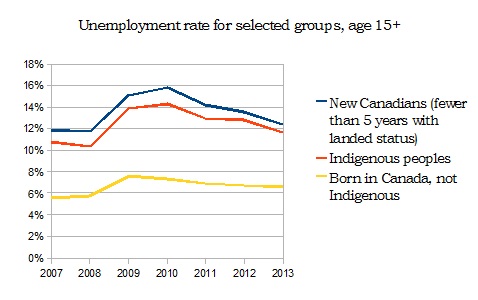Here’s a familiar trope: immigrants are industrious and hard-working. Here’s another, opposite trope: First Nations are idle and lazy. And here’s a graph that beautifully calls into question this neat pair of stereotypes.

It turns out that off-reserve First Nations workers and recent immigrants face the same unemployment rate – one that is much higher than that faced by workers born in Canada. As Angella MacEwen, who posted this graph, points out it highlights that “there are systemic barriers that need to be addressed” in the labour market.
On the one hand, there is a gaping disconnect between right-wing rhetoric that extolls immigrants and the actual struggles faced by new immigrants. Indeed, the irony is that the right’s discourse when confronted with reality brings out the systemic barriers rooted in racism better than the facts by themselves.
This systemic racism is at the source of the seeming confirmation of the myth of Indigenous as idle. Idle No More continues to challenge this myth in action. Here is blogger âpihtawikosisân challenging it with deserved exasperation:
I’m not even going to try to find a source that can refute this blatantly racist belief. There’s just too much packed into it. Stop. Stop using anecdotes about some guy you knew once. Stop saying you lived by a reserve and you know it all. Stop saying that our concerns are not legitimate. Stop denying the colonial relationship that has never ended in this country. Stop pretending that colonialism is our fault.
The cynical, lazy response of the purveyors of the industrious/idle tropes is to say, “you can’t win”: lazy or hard-working, any description is bound to be accused of racism. Yet uncovering the similarity of the racism beneath the rhetoric that comes from the confrontation with fact (see chart) is but the first step. The challenge is figuring out the differences, getting to the roots of the structures – their histories and present material roles.
The same structural racism can be parsed through different social and economic functions. First Nations hold claims to the land and resources that undergird Canada’s historically vital resource sectors. They are best-ignored reminders of past appropriation. Immigrants are a future that needs to be tamed, a source of hopeful energy that has to be incorporated into existing economic relations. Indeed, the children of immigrants on average do much better; as this National Post editorial inadvertently states, the treatment of first-generation immigration has an enormous socializing function. First Nations, on the other hand, have suffered generations of treatment as disposable – at the same time, proving time and again that they will actively defy such a fate.
In a different light, jobless recent immigrants and First Nations serve as different types of caution for all workers: there’s always someone waiting to take your place (the industrious) so that you’ll end up in a bad place (the idle). Both are caricatures, but that both of these threats stem from historically oppressed groups only reinforces them.
Of course, neither Indigenous workers nor recent immigrants are a homogenous group and any further analysis has to delve much deeper. Current trends need historical perspective. Generalities need unpacking. For example, as this detailed study points out, First Nations youth (15-24) experienced a smaller growth in unemployment than non-Aboriginal youth in the first four years after the last recession. At the same time, we should be careful even here, not falling into a trap that divides the acceptable “dynamism” of work (that can be low-wage, low-everything) from the dynamism of activation via movement like Idle No More.
In short, general facts can set the stage, debunking the easy answers and stereotypes so often paraded out. The eerily-similar unemployment rates faced by First Nations and recent immigrants put a fine point on how it is that some are called idle and others industrious, how social and economic roles are dispensed and how bigger structures create barriers. Any of these is a topic that goes far beyond one little chart and all require attention.